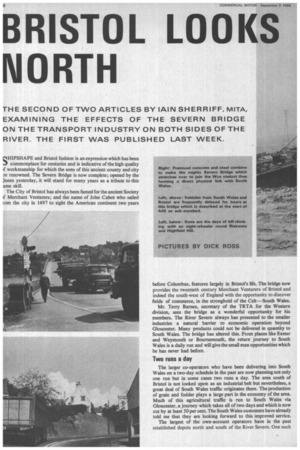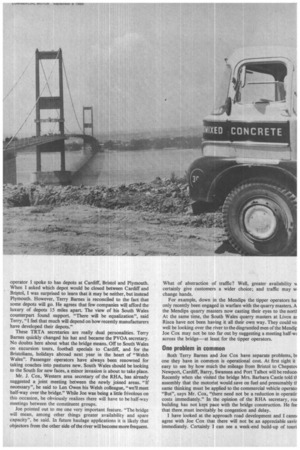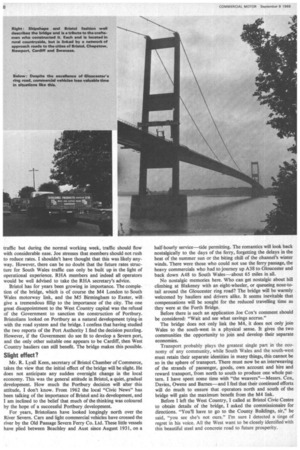6 BRISTOL LOOKS
Page 78

Page 79

Page 80

If you've noticed an error in this article please click here to report it so we can fix it.
COMMERCIAL MOTOR September 9 1966
NORTH
SHIPSHAPE and Bristol fashion is an expression which has been commonplace for centuries and is indicative of the high quality if workmanship for which the sons of this ancient county and city re renowned. The Severn Bridge is now complete; opened by the )ueen yesterday, it will stand for many years as a tribute to this ame skill.
The City of Bristol has always been famed for the ancient Society If Merchant Venturers; and the name of John Cabot who sailed rom the city in 1497 to sight the American continent two years before Columbus, features largely in Bristol's life. The bridge now provides the twentieth century Merchant Venturers of Bristol and indeed the south-west of England with the opportunity to discover fields of commerce, in the stronghold of the Celt—South Wales.
Mr. Terry Barnes, secretary of the TRTA for the Western division, sees the bridge as a wonderful opportunity for his members. The River Severn always has presented to the smaller industries a natural barrier to economic operation beyond Gloucester. Many products could not be delivered in quantity to South Wales. The bridge has altered this. From places like Exeter and Weymouth or Bournemouth, the return journey to South Wales is a daily run and will give the small man opportunities which he has never had before.
Two runs a day The larger co-operators who have been delivering into South Wales on a two-day schedule in the past are now planning not only one run but in some cases two runs a day. The area south of Bristol is not looked upon as an industrial belt but nevertheless, a great deal of South Wales traffic originates there. The production of grain and fodder plays a large part in the economy of the area. Much of this agricultural traffic is run to South Wales via Gloucester, a journey which takes all of two days and which is now Cut by at least 50 per cent. The South Wales customers have already told me that they are looking forward to this improved service.
The largest of the own-account operators have in the past established depots north and south of the River Severn. One such operator I spoke to has depots at Cardiff, Bristol and Plymouth. When I asked which depot would be closed between Cardiff and Bristol, I was surprised to learn that it may be neither, but instead Plymouth. However, Terry Barnes is reconciled to the fact that some depots will go. He agrees that few companies will afford the luxury of depots 15 miles apart. The view of his South Wales counterpart found support. "There will be equalization", said Terry, "I feel that much will depend on how recently manufacturers have developed their depots."
These TRTA secretaries are really dual personalities. Terry Barnes quickly changed his hat and became the PVOA secretary. No doubts here about what the bridge means. Off to South Wales on excursion tours, football specials to Cardiff, and for the Bristolians, holidays abroad next year in the heart of "Welsh Wales". Passenger operators have always been renowned for taking coaches into pastures new. South Wales should be looking to the South for new faces, a minor invasion is about to take place.
Mr. J. Cox, Western area secretary of the RHA, has already suggested a joint meeting between the newly joined areas. "If necessary", he said to Len Owen his Welsh colleague, "we'll meet half-way over the bridge." While Joe was being a little frivolous on this occasion, he obviously realizes there will have to be half-way meetings between the constituent groups.
Joe pointed out to me one very important feature. -The bridge will mean, among other things greater availability and spare capacity", he said. In future haulage applications it is likely that objectors from the other side of the river will become more frequent. What of abstraction of traffic? Well, greater availability NN certainly give customers a wider choice; and traffic may w change hands.
For example, down in the Mendips the tipper operators ha only recently been engaged in warfare with the quarry masters. A the Mendips quarry masters now casting their eyes to the nortl At the same time, the South Wales quarry masters at Livox ar Risca have not been having it all their own way. They could vu well be looking over the river to the disgruntled men of the Mend* Joe Cox may not be too far out by suggesting a meeting half-wl across the bridge at least for the tipper operators.
One problem in common
Both Terry Barnes and Joe Cox have separate problems, Ix one they have in common is operational cost. At first sight it easy to see by how much the mileage from Bristol to Chepsto. Newport, Cardiff, Barry, Swansea and Port Talbot will be reducei Recently when she visited the bridge Mrs. Barbara Castle told 0assembly that the motorist would save on fuel and presumably tl same thinking must be applied to the commercial vehicle operato "But", says Mr. Cox, "there need not be a reduction in operatir costs immediately." In the opinion of the RHA secretary, roa building has not kept pace with the bridge construction. He fee that there must inevitably be congestion and delay.
I have looked at the approach road development and I cann4 agree with Joe Cox that there will not be an appreciable savir immediately. Certainly I can see a week-end build-up of touri traffic but during the normal working week, traffic should flow with considerable ease. Joe stresses that members should not rush to reduce rates. I shouldn't have thought that this was likely anyway. However, there can be no doubt that the future rates structure for South Wales traffic can only be built up in the light of operational experience. RHA members and indeed all operators would be well advised to take the RHA secretary's advice.
Bristol has for years been growing in importance. The completion of the bridge, which is of course the M4 London to South Wales motorway link, and the M5 Birmingham to Exeter, will , give a tremendous fillip to the importance of the city. The one great disappointment to the West Country capital was the refusal of the Government to sanction the construction of Portbury. Bristolians looked on Portbury as a natural development tying-in with the road system and the bridge. I confess that having studied the two reports of the Port Authority I find the decision puzzling. However, if the Government do see fit to develop a Severn port, and the only other suitable one appears to be Cardiff, then West Country hauliers can still benefit. The bridge makes this possible.
Slight effect?
Mr. R. Lyall Keen, secretary of Bristol Chamber of Commerce, takes the view that the initial effect of the bridge will be slight. He does not anticipate any sudden overnight change in the local economy. This was the general attitude in Bristol, a quiet, gradual development. How much the Portbury decision will alter this attitude, I don't know. From 1962 the local "Civic News" has been talking of the importance of Bristol and its development, and I am inclined to the belief that much of the thinking was coloured by the hope of a successful Portbury development.
For years, Bristolians have looked longingly north over the River Severn. Cars and light commercial vehicles have crossed the river by the Old Passage Severn Ferry Co. Ltd. These little vessels have plied between Beachley and Aust since August 1931, on a half-hourly service—tide permitting. The romantics will look back nostalgically to the days of the ferry, forgetting the delays in the heat of the summer sun or the biting chill of the channel's winter winds. There were those who could not use the ferry passage, the heavy commercials who had to journey up A38 to Gloucester and back down A48 to South Wales—about 65 miles in all.
No nostalgic memories here. Who can get nostalgic about hill climbing at Blakeney with an eight-wheeler, or queueing nose-totail around the Gloucester ring road? The bridge will be warmly welcomed by hauliers and drivers alike. It seems inevitable that compensations will be sought for the reduced travelling time as they were at the Forth Bridge.
Before there is such an application Joe Cox's comment should be considered: "Wait and see what savings accrue."
The bridge does not only link the M4, it does not only join Wales to the south-west in a physical sense. It gives the two communities the opportunity to join and develop their separate economies.
Transport probably plays the greatest single part in the economy of any community, while South Wales and the south-west must retain their separate identities in many things, this cannot be so in the sphere of transport. There must now be an interweaving of the strands of passenger, goods, own account and hire and reward transport, from north to south to produce one whole pattern. I have spent some time with "the weavers"—Messrs. Cox, Davies, Owens and Barnes—and I feel that their continued efforts will do much to ensure that operators north and south of the bridge will gain the maximum benefit from the M4 link.
Before I left the West Country, I called at Bristol Civic Centre to obtain details of the bridge, I asked the commissionaire for directions. "You'll have to go to the County Buildings, sir," he said, "you see she's not ours." I'm sure I detected a tinge of regret in his voice. All the West want to be closely identified with this beautiful steel and concrete road to future prosperity.
































































































































